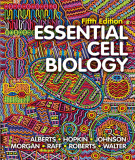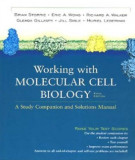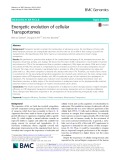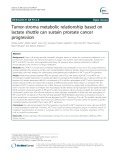
Transport across cell membranes
-
Part 2 book "Essential cell biology" includes content: Membrane structure, transport across cell membranes, how cells obtain energy from food, energy generation in mitochondria and chloroplasts, intracellular compartments and protein transport, cell signaling, cytoskeleton, the cell division cycle, sexual reproduction and genetics, cell communities: tissues, stem cells and cancer.
 467p
467p  muasambanhan08
muasambanhan08
 01-03-2024
01-03-2024
 3
3
 1
1
 Download
Download
-
Part 1 book "Molecular cell biology" includes content: Life begins with cells, chemical foundations, protein structure and function, basic molecular genetic mechanisms, biomembranes and cell architecture, integrating cells into tissues, transport of ions and small molecules across cell membranes, cellular energetics, molecular genetic techniques and genomics, molecular structures of genes and chromosomes, transcriptional control of gene expression.
 490p
490p  muasambanhan07
muasambanhan07
 18-02-2024
18-02-2024
 2
2
 2
2
 Download
Download
-
Part 2 book "Alberts - Essential cell biology" includes content: Membrane structure; transport across cell membranes; how cells obtain energy from food; energy generation in mitochondria and chloroplasts; intracellular compartments and protein transport; cell signaling; cytoskeleton; the cell division cycle chapter 19 sexual reproduction and the power of genetics; cell communities - tissues, stem cells, and cancer
 480p
480p  muasambanhan01
muasambanhan01
 13-12-2023
13-12-2023
 4
4
 2
2
 Download
Download
-
Gold nanochannels were prepared by plating electrolessly gold within the pores of polycarbonate filter membranes (PCTMs). These PCTMs with cylindrical Au nanotubules of uniform radius and high density can be used as a convenient model system to investigate the mechanism of particle transport through nanotubules. The transport properties of phenol through a modified Au nanotubule membrane were studied.
 9p
9p  langthannam
langthannam
 29-12-2021
29-12-2021
 4
4
 0
0
 Download
Download
-
Transporter proteins mediate the translocation of substances across the membranes of living cells. Many transport processes are energetically expensive and the cells use 20 to 60% of their energy to power the transportomes. We hypothesized that there may be an evolutionary selection pressure for lower energy transporters.
 11p
11p  vibeauty
vibeauty
 23-10-2021
23-10-2021
 6
6
 1
1
 Download
Download
-
Lecture Principles of Biology - Chapter 7: Membranes. After completing this section, you will understand the knowledge about roles of biological membranes, the lipid bilayer and the fluid mosaic model, transport and transfer across cell membranes, specialized contacts (junctions) between cells,...
 77p
77p  bachtudu
bachtudu
 30-09-2021
30-09-2021
 12
12
 1
1
 Download
Download
-
Aquaporins (AQPs) facilitate transport of water and small solutes across cell membranes and play an important role in different physiological processes in plants. Despite their importance, limited data is available about AQP distribution and function in the economically important oilseed crop peanut, Arachis hypogea (AABB).
 13p
13p  visilicon2711
visilicon2711
 20-08-2021
20-08-2021
 9
9
 1
1
 Download
Download
-
The amino acid/auxin permease (AAAP) family represents a class of proteins that transport amino acids across cell membranes. Members of this family are widely distributed in different organisms and participate in processes such as growth and development and the stress response in plants.
 12p
12p  vilichoo2711
vilichoo2711
 23-06-2021
23-06-2021
 7
7
 1
1
 Download
Download
-
Tumor-stroma metabolic relationship based on lactate shuttle can sustain prostate cancer progression
Cancer cell adopts peculiar metabolic strategies aimed to sustain the continuous proliferation in an environment characterized by relevant fluctuations in oxygen and nutrient levels. Monocarboxylate transporters MCT1 and MCT4 can drive such adaptation permitting the transport across plasma membrane of different monocarboxylic acids involved in energy metabolism.
 14p
14p  virose2711
virose2711
 25-09-2020
25-09-2020
 14
14
 0
0
 Download
Download
-
Long-chain fatty acids are the most abundant fatty acids and are essential for various physiological processes. Translocation of long-chain fatty acids across cell membrane is dependent on transport proteins.
 10p
10p  vinasaki2711
vinasaki2711
 12-11-2019
12-11-2019
 13
13
 1
1
 Download
Download
-
(BQ) Part 1 of the document BRS Physiology presents the following contents: Cell Physiology, neurophysiology, cardiovascular physiology, respiratory physiology. Invite you to consult.
 158p
158p  thangnamvoiva2
thangnamvoiva2
 23-06-2016
23-06-2016
 73
73
 6
6
 Download
Download
-
(BQ) Part 1 of the document Rapid review physiology presents the following contents: Cell physiology, neurophysiology, endocrine physiology, cardiovascular physiology. Invite you to consult.
 156p
156p  thangnamvoiva2
thangnamvoiva2
 23-06-2016
23-06-2016
 40
40
 3
3
 Download
Download
-
The passage of salt (NaCl) across a plasma membrane is of primary importance to most cells. The chloride ion (Cl–) usually crosses the plasma membrane because it is attracted by positively charged sodium ions (Na+). First sodium ions are pumped across a membrane, and then chloride ions simply diffuse through channels that allow their passage. As noted in Figure 4.2a, the genetic disorder cystic fibrosis results from a faulty chloride channel. Ordinarily, after chloride ions have passed though the membrane, sodium ions (Na+) and water follow.
 148p
148p  commentcmnr
commentcmnr
 03-06-2013
03-06-2013
 52
52
 7
7
 Download
Download
-
Anandamide is an endogenous ligand for cannabinoid receptor and its protein-mediated transport across cellular membranes has been demonstrated in cells derived from brain as well as in cells of the immune system. This lipid is inactivated via intracellular degradation by a fatty acid amidohydrolase (FAAH). In the present study, we report that rabbit platelets, in contrast to human platelets, do not possess a carrier-mediated mechanism for the transport of [ 3 H]anandamide into the cell, i.e. cellular uptake was not temperature dependent and its accumulation was not satu-rable. ...
 9p
9p  tumor12
tumor12
 20-04-2013
20-04-2013
 22
22
 1
1
 Download
Download
-
Transport of solutes and polypeptides across membranes is an essential process for every cell. In the past, much focus has been placed on helical transporters. Recently, the b-barrel-shaped transporters have also attracted some attention. The members of this family are found in the outer bacterial membrane and the outer membrane of endosymbiotically derived organ-elles.
 12p
12p  awards
awards
 06-04-2013
06-04-2013
 25
25
 2
2
 Download
Download
-
Over the past several years, the importance of regulated nuclear transport processes for tumor suppressors has become evident. Proteins with a molecular mass greater than 40 kDa can enter the nucleus only by active transport across the nuclear membrane. The most common pathway by which this occurs is via the importin alpha⁄beta pathway, whereby the cargo protein binds importin alpha.
 7p
7p  viettel02
viettel02
 19-02-2013
19-02-2013
 38
38
 2
2
 Download
Download
-
Parkinson’s disease is characterized by preferential degeneration of the dopamine-producing neurons of the brain stem substantia nigra. Imbal-ances between mechanisms governing dopamine transport across the plasma membrane and cellular storage vesicles increase the level of toxic pro-oxidative cytosolic dopamine.
 13p
13p  mobifone23
mobifone23
 07-01-2013
07-01-2013
 39
39
 2
2
 Download
Download
-
Bacterial type IV secretion systems (T4SS) form supramolecular protein complexes that are capable of transporting DNA or protein substrates across the bacterial cell envelope and, in many cases, also across eukaryotic target cell membranes.
 10p
10p  cosis54
cosis54
 05-01-2013
05-01-2013
 42
42
 4
4
 Download
Download
-
Abnormalities of the Glycolytic Pathway (Fig. 101-1) Since red cells, in the course of their differentiation, have sacrificed not only their nucleus and their ribosomes but also their mitochondria, they rely exclusively on the anaerobic portion of the glycolytic pathway for producing energy in the form of ATP. Most of the ATP is required by the red cell for cation transport against a concentration gradient across the membrane. If this fails, due to a defect of any of the enzymes of the glycolytic pathway, the result will be hemolytic disease.
 6p
6p  thanhongan
thanhongan
 07-12-2010
07-12-2010
 87
87
 4
4
 Download
Download
CHỦ ĐỀ BẠN MUỐN TÌM




















![Báo cáo khoa học: Uptake and metabolism of [3H]anandamide by rabbit platelets Lack of transporter? Báo cáo khoa học: Uptake and metabolism of [3H]anandamide by rabbit platelets Lack of transporter?](https://tailieu.vn/image/document/thumbnail/2013/20130420/tumor12/135x160/4891366448154.jpg)









